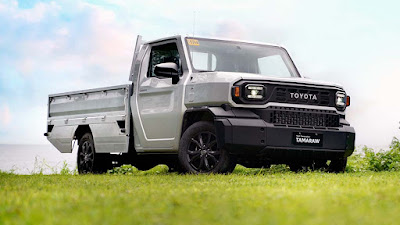Daihatsu, the Japanese automaker owned by Toyota, has admitted to forging the results of safety tests for its vehicles for more than 30 years.
The brand, best known for manufacturing small passenger cars, was rocked by a scandal last week when an independent third-party committee had found evidence of tampering with safety tests on as many as 64 vehicle models, including those sold under the Toyota brand.
According to a report released last Wednesday by the investigative committee, 174 more cases were found of Daihatsu manipulating data, making false statements, or improperly tinkering with vehicles to pass safety certification tests. This is on top of two separate safety test irregularities found last April and May.
So far, no model exported to the Philippines or sold by Toyota Motor Philippines has been linked to the safety scandal. Vehicles manufactured in Indonesia (where Toyota Motor Philippines sources some of its vehicles) have also been cleared.
According to the report, the oldest case of safety test-related tampering was traced back to 1989, with a noted increase in the number of cases since 2014 covering brands in which Daihatsu has an OE supply agreement with such as Mazda, Subaru, and Toyota.
In response, Toyota says it has promised to shake up its subsidiary, saying that “fundamental reform is needed to revitalize Daihatsu.” It will also review every aspect of Daihatsu’s operations including how the company is structured, its management and its operations.
There have been no reports of accidents or deaths due to the rigged tests.
Daihatsu was first founded in 1951, with Toyota first becoming a major shareholder in 1967, increasing its stake to 51.2 percent in 1998. In 2016, Daihatsu became a wholly-owned subsidiary.





Sad.
ReplyDeleteThirty years! That's mind-boggling! Families of fatalities or injured in Daihatsu car accidents should look into this. If there is an established pattern of failure, that could be a huge lawsuit/s. Also, making preemptive statements like cars for Philippines are cleared is like holding a can of worms. Let the investigation make this declaration, not the people or company that lied through its teeth in the first place.
ReplyDeleteBoycott Daihatsu. But don't buy crappy Chinese cars too
ReplyDeleteIto na naman ang mga chinese cars haters, haayz..seeking attention to be responded to and mapansin.
ReplyDelete100% avoid and not buy Toyota Avanza,Veloz,Raize,Rush and Wigo ☓️☓️☓️
ReplyDeleteBetter buy much safer,value for money and more high quality vehicles from
Geely,Changan,GAC,Chery,MG,GWM,Honda,Nissan and Mitsubishi 👍👍
Life and safety are much more important than resale value of the vehicle.
LOL!!! Ba't nasali mga chinese brands.
DeleteChina cars more safer and high quality??? The biggest joke of 2023💥💥💥
DeleteI should get a refund for my Daihatsu Charade.
ReplyDeleteUna, hino. Tas ngayon pati daihatsu kasama pala. Naku po...
ReplyDeleteToyota is in trouble
ReplyDeleteMaybe Toyota could've been merged with Nissan when the former suffered from a massive vehicle recall in 2010, anyway Nissan during that period was bigger in terms of profits than Toyota so the reason Toyota could survive under Nissan ownership in 2010 was because of the impact of Renault's ownership in Nissan thanks to the help of the French government.
DeleteEspecially during the 2008 recession and 2011 tsunami in Japan meant that Nissan (under Renault) survived and succeeded due to the fact that the French automaker was lucky to retain its alliance that began in 1999, so in a scenario where Toyota dumps its things during the latter's product recall meant if Toyota were a party of Nissan - of Renault-Nissan Alliance that time - then Toyota would just transform all of its products into Nissans but that may even affect the Renault partnership and as a result Nissan would become Japan's leading manufacturer by early 2011 (even if the tsunami would've happened since Japan is calamity-prone and therefore Japanese carmakers struggle to find alternative markets for both sales and production.)
That tells me why Daihatsu no longer sells cars in North America just as the former does the same thing in Europe, the United Kingdom and Ireland, as this also explains that Toyota's European division opted to join forces with Peugeot (now called too as Stellantis) to develop the Aygo microcar that was also sold by Peugeot as the 107 and later 108 while Citroen did the same way with the C1 - interestingly these smaller Franco-Japanese cars were based on Daihatsu technology not since the engine used in the 107-108/C1/Aygo was based on Daihatsu but also the use of Daihatsu tech by a French carmaker deeply explained that the predecessor (Peugeot 106 and Citroen Saxo aka Citroen Chanson in Japan) was too old-fashioned when it was still on sale in the 2000s.
ReplyDeleteAlso in turn, Toyota opted to deepen its partnership with Peugeot (Europe only) to rebadge the latter's commercial vehicles as the former, so this is was also the reason why the current and previous HiAce vans are neither seen nor sold within a myriad of European markets -- but for the record the Toyota-badged Peugeot cars were only sold in limited numbers compared to the French (Peugeot and Citroen) versions... (Even Fiat and Opel/Vauxhall versions of the commercial vehicles Peugeot still supplies to Toyota are selling well since Stellantis is fundamentally and technically a pan-European automaker so Toyota should honestly depend less on Europe like how its fellow compatriots refuse to expand there.)